This is your all-in-one guide for mastering garden soil care. I’ll walk you through how to understand, nurture, and enhance the soil in your garden for plant health and vibrant growth.
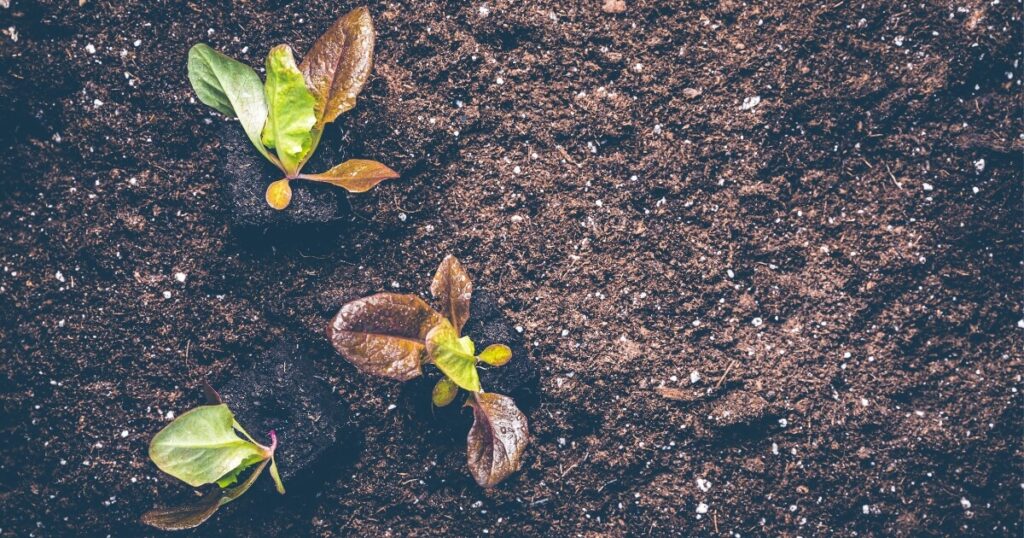
The challenge lies in the fact different plants have different needs, and soil types can vary dramatically, even within the same garden. Without knowing what you’re working with, providing the right environment for your plants to flourish is tough.
So, I’ll break down the different types of soil, how to test and improve yours, and the best tools for the job. This guide offers practical advice and has links to my complete step-by-step guides. Let’s get started!
Understanding Soil
What is Soil?
Soil is the essential foundation of your garden, a mix of minerals, organic matter, and diverse microorganisms. It’s the support system for your plants, providing them with nutrients, water, and a stable base for root growth.
Types of Soil
Different soils have different strengths and challenges, and I think it’s important that you figure it out before you start planting. You want to give your garden or lawn the best chance for growth, and it’s much easier to amend them now rather than later.

Here are 6 types of soil and what they mean for your plants:
- Sandy Soil: Sandy soil drains well but doesn’t hold nutrients for long. It’s ideal for plants that like dry conditions.
- Clay Soil: Rich in nutrients and good at holding water, clay soil can be heavy and slow to drain. It’s great for moisture-loving plants but might need aeration for better root growth.
- Silty Soil: This soil type is fertile and holds moisture well, a good all-around option for various plants. It’s softer and retains water better than sandy soil.
- Loamy Soil: This is a balanced mix of sand, silt, and clay. It’s fertile, drains well, is easy to work with, and ideal for most plants.
- Peaty Soil: High in organic matter, peaty soil retains a lot of moisture. It’s often acidic, so you may need to adjust its pH for certain plants.
- Chalky Soil: With a stony texture and alkaline nature, chalky soil may require added nutrients for optimal plant growth. It’s well-draining but can be challenging for some plants.
Assessing Your Soil
Understanding what type of soil you have is just the start. Now, let’s talk about assessing its health and making it the best it can be for your plants.
Testing Your Soil
Testing your soil is like giving it a health check-up.
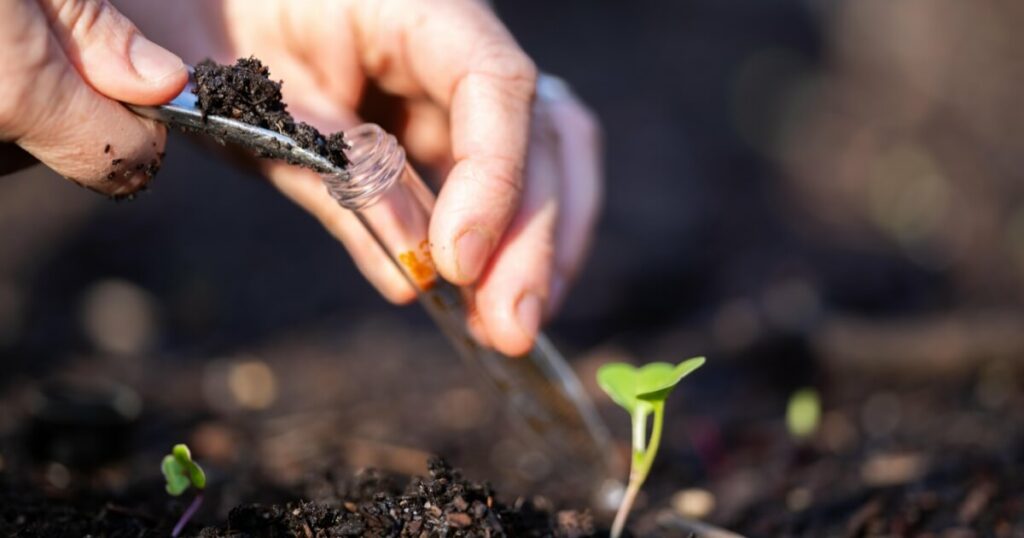
Here’s how you can do it:
- Feel and Look: Grab a handful of moist soil. Does it feel gritty (sandy), smooth (silty), or sticky (clay)? Is it dark and crumbly (rich in organic matter)? These observations give you a basic idea of your soil type.
- pH Test: Your garden’s pH level can make or break plant health. You can use a simple test kit from a garden store to find out if your soil is acidic, neutral, or alkaline. Most plants like slightly acidic to neutral soil (pH 6.0 to 7.0).
- Professional Soil Test: Consider a professional soil test for a more detailed analysis. This can tell you about nutrient levels and offer specific recommendations for amendments. It takes a lot of the guesswork out of it, but they typically cost between $75 – $100, depending on your area.
For a more in-depth guide, check out my guide on how to test soil pH here.
Improving Soil Health
Once you know your soil type and pH, you can start improving it:
- Organic Matter: Adding compost is a universal solution for almost all soil types. It improves drainage in clay soils, helps sandy soils retain nutrients, and boosts overall soil health.
- Aeration: Aeration is especially important for compacted or clay soils. This helps air, water, and nutrients to penetrate the soil. Simple tools like a garden fork can do the job.
- Adjusting the pH: If your soil is too acidic or alkaline, you can adjust it. Lime can reduce acidity (raise pH in soil), while sulfur can make alkaline soil more acidic.
Regularly testing and amending your soil can dramatically improve its health, leading to happier, healthier plants.
Soil Nutrition & Amendments
Now that you’ve got a handle on your soil type and health let’s chat about feeding your soil. Here’s what you need to know about soil nutrition and how to give your soil a nutritious boost.
Essential Nutrients
Your plants need a mix of nutrients, but here are the big three:
- Nitrogen (N): Think of nitrogen as the growth booster. It’s key for leafy growth and green color. Here’s how you can add nitrogen to your soil.
- Phosphorus (P): Phosphorus is all about roots and flowers. It helps develop strong root systems and boosts flowering and fruiting.
- Potassium (K): This nutrient is a bit of a plant health coach. It plays a role in overall plant health, helping with disease resistance and water intake.
There are also other important nutrients such as calcium, magnesium, and sulfur, plus a bunch of micronutrients that plants need in smaller amounts.
Adding Amendments
So, how do you make sure your soil has all these nutrients?
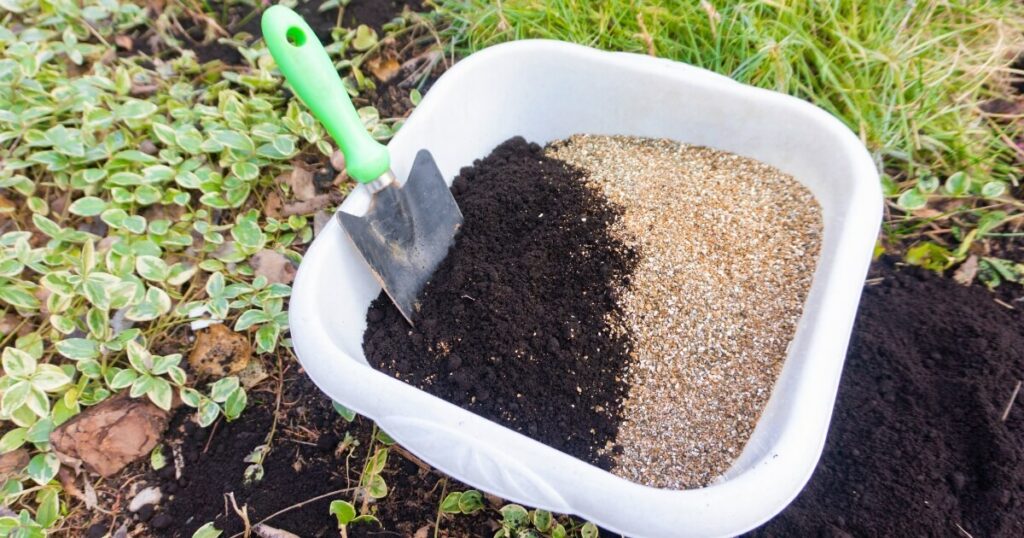
Here’s where amendments come in:
- Compost: Your garden’s best friend. Compost improves soil structure, adds nutrients, and boosts microbial life. It’s like a multivitamin for your soil.
- Fertilizers: They come in all shapes and sizes – organic, synthetic, slow-release, liquid. Pick what works best for your garden. Remember, more isn’t always better. Follow the instructions to avoid overfeeding.
- Specialized Amendments: You might need specific amendments depending on your soil test results. Bone meal for phosphorus, blood meal for nitrogen, or Epsom salt for magnesium are a few examples.
Adding the right amendments helps your plants grow strong and healthy. It’s like cooking a great meal – the better the ingredients, the better the results.
Sustainable Soil Practices
Let’s dig into some earth-friendly practices you can do easily for your soil.
Composting
Composting is like recycling for your garden. You turn kitchen scraps and yard waste into black gold for your plants.
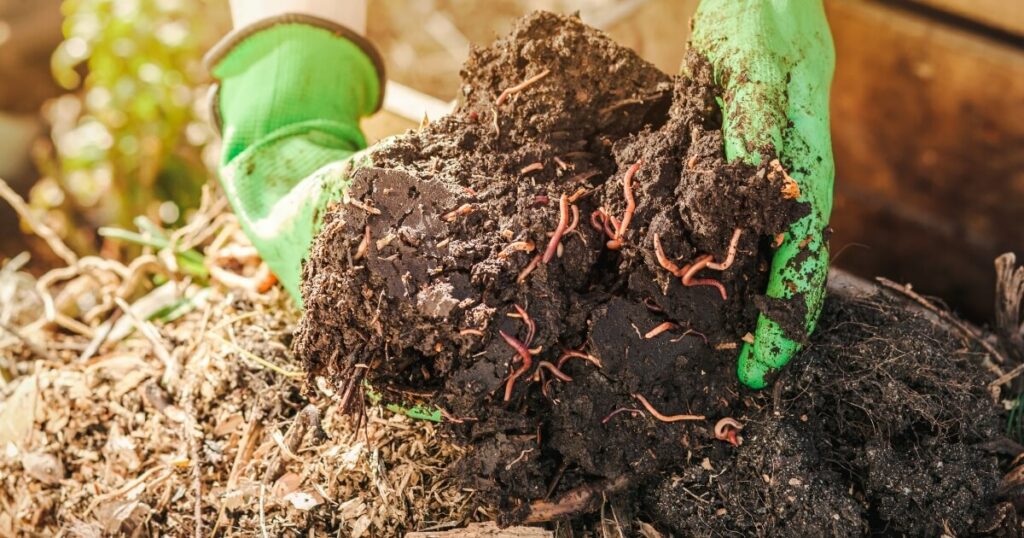
Here’s why composting is a win-win:
- Waste Reduction: By composting, you’re reducing landfill waste. Less garbage, more garden goodness.
- Soil Health: Compost adds nutrients and improves soil structure. It’s like a natural soil conditioner that helps retain moisture and prevent plant diseases.
Starting a compost pile is easy. Mix green and brown materials, keep it moist, and turn it regularly. You’ll have rich compost ready for your garden in a few months. Kitchen scraps, grass clippings, twigs, and leaves are all great options for compost.
Mulching
Think of mulch as a protective blanket for your soil. It’s not just about making your garden or flower beds look neat.

Mulching has some serious benefits:
- Moisture Retention: Mulch helps keep your soil moist, so you water less. It’s a time and water saver.
- Weed Control: A layer of mulch can suppress certain weeds, meaning less work for you and more nutrients for your plants.
- Temperature Regulation: Mulch can help keep your soil cooler in summer and warmer in winter. This creates a more consistent environment for plant roots.
You can use mulches like wood chips, straw, or grass clippings. They eventually break down, adding organic matter to the soil. Or, go for inorganic options like stones or landscape fabric for a different look and less frequent replacement.
Special Considerations
Soil and Potted Plants
Caring for soil in pots is a bit different than in the garden. Here’s what to keep in mind:
- Drainage: Ensure pots have holes for excess water to escape. Waterlogged soil can harm plant roots.
- Potting Mixes: Use a quality potting mix designed for containers. It’s lighter and provides better aeration than regular garden soil.
- Nutrient Management: Nutrients wash out faster in pots, so regular feeding might be necessary.
Seasonal Soil Care
The needs of your soil change with the seasons:
- Spring: Time to prepare your soil. Clear debris, add compost, and prepare beds for planting.
- Summer: Keep up with watering and mulching. Monitor nutrient levels, especially in heat and heavy rain.
- Fall: Add compost or manure to enrich the soil. It’s a good time for planting perennials and cover crops.
- Winter: Protect your soil from erosion and nutrient loss. Cover it with mulch or plant a cover crop if your area can support it. I wrote a guide on how to keep outdoor plants alive during winter which covers similar strategies.
You can maintain a healthy, productive garden year-round by adapting your soil care to these needs.
Tools & Equipment
The right tools and equipment can make soil care easier and more effective.
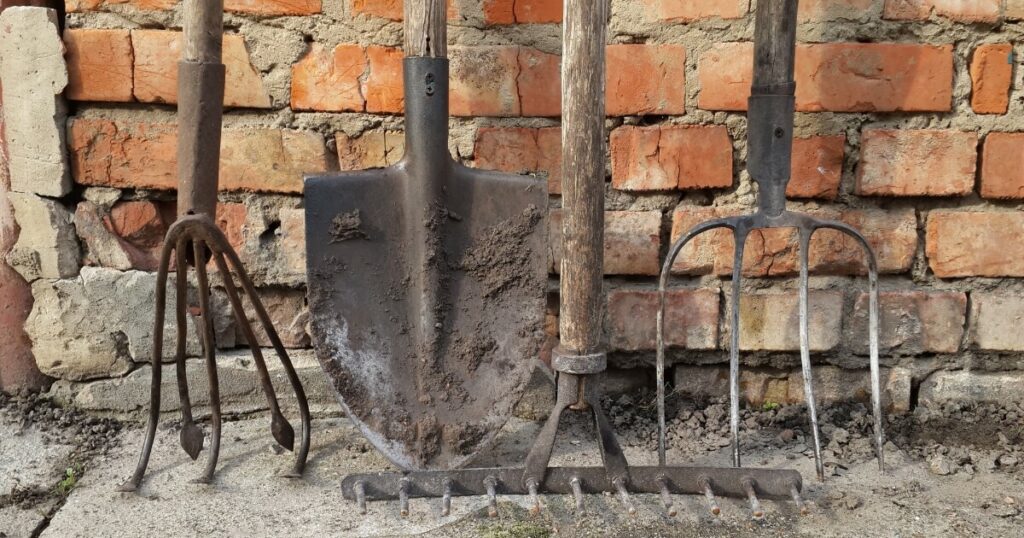
Here’s a rundown of some essential items that I think are most important for soil management in your garden:
Basic Tools for Soil Work
- Spade and Shovel: For digging, turning soil, and planting. A spade has a flat blade for cutting through sod and roots, while a shovel is ideal for moving soil. Here are my favorite garden shovel picks.
- Garden Fork: Great for loosening and aerating soil, especially in beds where a spade might be too harsh.
- Hoe: Useful for weeding and shaping soil surfaces. Different types have specific uses, like cultivating or making furrows for seeds.
Soil Testing and Maintenance Equipment
- Soil pH Tester: A simple tool for measuring soil acidity or alkalinity. Knowing your soil’s pH is important for understanding what plants will thrive and what amendments may be needed.
- Compost Bin or Tumbler: Essential for turning kitchen and garden waste into compost. Compost enriches the soil and supports healthy plant growth.
- Watering Can or Hose: For maintaining soil moisture. Drip irrigation systems or soaker hoses are my favorite for prolonged dry spells.
Specialized Tools for Specific Tasks
- Broadfork: Excellent for aerating larger beds without disturbing soil structure.
- Mulch Spreader: Handy for evenly distributing mulch over large areas.
- Wheelbarrow or Garden Cart: A must-have for moving soil, compost, mulch, or plants around your garden.
Good tools can last a long time if you take care of them!
In Summary
Alright, let’s wrap up what we’ve covered about soil care.
Getting to know your soil is like getting to know a close friend. And just like with any good friendship, understanding these traits helps you provide the best care.
Testing and improving your soil might seem like extra work, but trust me, it pays off. A bit of compost here, the right fertilizer there, and you’re on your way to a flourishing garden.
And let’s not forget about the tools of the trade. From a simple spade to a handy pH tester, having the right equipment makes your soil care tasks smoother and more enjoyable.
Keep exploring, testing, and nurturing your soil, and watch as your garden rewards you with vibrant growth and blooms. Soil care is an ongoing task that never ends. But each season, you’ll learn more, and it’ll all be worth it when you see what your hard work produces.